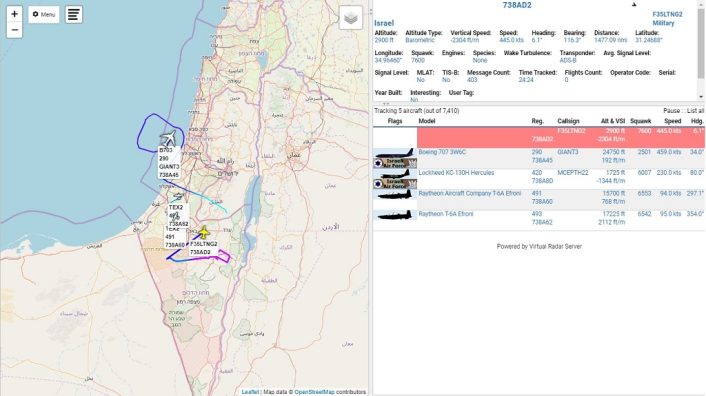F-35s can be tracked online almost daily. However, the fact that the IDF allowed journalists to post the screenshots of its stealth jet tracking on FR24.com is worth a comment.
On January 20, 2020, an F-35 Adir of the Israeli Air Force, with callsign F35LTNG2 and transponder hex code 738AD2, appeared on popular flight tracking websites like FlightRadar24 and ADS-B Exchange. The fact in se was already interesting because IAF’s tactical jet never appear in the aforementioned websites, but most notably this Adir had his transponder transmitting (or squawking, using a more technical term) 7600, which is an international code used to signal a loss of communications.
An #IAF F-35I “Adir” revealed around noon its location on @flightradar24 over the Dimona Nuclear Reactor squawking 7600 (Communication Failure). Publication authorized by the Military Censor. Via @ItayBlumental and @Ynetalerts pic.twitter.com/r3URAH0QmG https://t.co/R6fSfvDjXV
— Observer IL (@Obs_IL) January 20, 2020
The F-35 was tracked for about 25 minutes around 10.00 UTC near the Shimon Peres Negev Nuclear Research Center, as pointed out on Twitter by some Israeli users. The same users reported also an official statement of the Israeli Defense Forces about the incident, after the military censorship authorized the publication, translated here:
During a routine training flight in the south of the country, a malfunction was discovered in the aircraft’s contact device. In order to communicate with the additional aircraft in training, the pilot operated the aircraft’s detection system so that other aircraft could detect it in the air without speaking to it.
With this statement, the IAF acknowledged the radio failure of the F-35 and the subsequent loss of communications, with the pilot resorting to Mode-S/ADS-B to signal the problem and return to base without the risk of a collision with other aircraft in the area.

This is not the first time an F-35 Adir was visible on flight tracking websites. A similar occurrence, but without the emergency situation, happened back in 2018, when another Adir was tracked above the sea near Gaza heading north for about an hour. That time, though, the hex code belonged to a US F-35 and the IDF didn’t publish any official statement.
*Surprisingly Israeli military censorship ok’d Israeli journalists to publish* this is something I will bookmark so that I have it at hand next time some weirdo complaints about OPSEC after publishing an article on flight tracking or a simple screenshot. https://t.co/uE87n2gwbC
— David Cenciotti (@cencio4) January 20, 2020
As mentioned many times here on TheAviationist, military aircraft involved in operational missions turn off their transponders/switch to encrypted transmissions but, at times, they keep it on as, maybe, a show of presence, as done by strategic ISR assets in sensitive regions like the Black Sea and the Baltic Sea or, more recently, during the US build up in the Middle East following the US Embassy attack in Baghdad.
You can find more information about the ADS-B system and its relationship with military aviation in this previous article by our Editor David Cenciotti. The following thread is also interesting, since it covers most of the “stereotypes” and paranoia surrounding OSINT on flight tracking:
Every time I publish an article like this, with some basic OSINT analysis based on ADS-B, radio comms, movements observation, etc. I get comments like: “this is an OPSEC violation” or “Twitter and flight tracking websites have made confidential details public, etc. This is BS. https://t.co/T8Dxo61RGq
— David Cenciotti (@cencio4) January 7, 2020
In short:
- pilots are aware that they are visible on flight tracking websites
- pilots are aware they radio comms can be heard if not encrypted
- if ADS-B is turned on, it means that it is done on purpose or at least consciously








